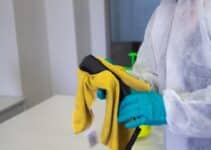Green commercial floor care refers to the use of sustainable and environmentally-friendly practices and products in the maintenance and cleaning of commercial floors. It involves minimizing the use of harmful chemicals, reducing waste, and implementing energy-efficient methods. Sustainability has become increasingly important in the business world as companies recognize the need to reduce their environmental impact and operate in a more socially responsible manner.
Key Takeaways
- Green commercial floor care solutions offer numerous benefits, including cost savings, improved indoor air quality, and reduced environmental impact.
- Eco-friendly cleaning products are essential for sustainable floor care, as they are free of harmful chemicals and toxins that can harm human health and the environment.
- Choosing the right green floor care equipment is crucial for achieving optimal results and minimizing environmental impact.
- Professional floor care services play a critical role in sustainability, as they have the expertise and resources to implement effective green floor care practices.
- Best practices for maintaining green floors in high-traffic areas include regular cleaning and maintenance, using walk-off mats, and implementing a floor care program.
- Successful case studies demonstrate the effectiveness of green floor care in commercial settings, including improved indoor air quality and reduced environmental impact.
- Educating employees and customers on sustainable floor care is essential for achieving long-term sustainability goals.
- The future of green commercial floor care is focused on innovation and trends, including the use of robotics and automation to improve efficiency and reduce environmental impact.
- Taking action towards a greener future with sustainable floor care solutions is essential for protecting human health and the environment while achieving cost savings and other benefits.
Benefits of Sustainable Floor Care Solutions
One of the key benefits of using sustainable floor care solutions is the reduced environmental impact. Traditional cleaning products often contain harsh chemicals that can be harmful to the environment when they are washed down drains or disposed of improperly. By using eco-friendly alternatives, businesses can minimize their contribution to water pollution and reduce their carbon footprint.
Another advantage of sustainable floor care is improved indoor air quality. Traditional cleaning products often release volatile organic compounds (VOCs) into the air, which can cause respiratory problems and other health issues. Eco-friendly cleaning products, on the other hand, are made from natural ingredients that are safe for both humans and the environment.
In addition to the environmental and health benefits, sustainable floor care solutions can also lead to cost savings in the long run. While eco-friendly products may have a higher upfront cost, they are often more concentrated and require less product per use. This means that businesses can save money by using less product over time. Furthermore, sustainable practices such as proper maintenance and regular cleaning can extend the lifespan of floors, reducing the need for costly repairs or replacements.
Understanding the Importance of Eco-Friendly Cleaning Products
Traditional cleaning products often contain harmful chemicals such as ammonia, bleach, and phosphates. These chemicals can have a negative impact on both human health and the environment. For example, ammonia can irritate the skin, eyes, and respiratory system, while bleach can release toxic fumes when mixed with other substances. Phosphates, commonly found in detergents, can contribute to water pollution and harm aquatic life.
On the other hand, eco-friendly cleaning products are made from natural and biodegradable ingredients that are safe for both humans and the environment. They do not contain harmful chemicals or toxins, making them a healthier alternative for employees and customers. Additionally, eco-friendly products are often produced using sustainable manufacturing practices, further reducing their environmental impact.
Choosing the Right Green Floor Care Equipment for Your Business
When selecting equipment for green floor care, there are several factors to consider. First, businesses should look for equipment that is energy-efficient and minimizes water usage. This can help reduce both energy consumption and water waste. Additionally, businesses should choose equipment that is durable and long-lasting, as this can help minimize waste and the need for frequent replacements.
There are several examples of sustainable floor care equipment available on the market. For example, there are low-moisture carpet cleaning machines that use less water and require shorter drying times. There are also floor scrubbers and sweepers that are battery-powered or use alternative fuels, reducing emissions and energy consumption. By investing in sustainable equipment, businesses can not only reduce their environmental impact but also improve the efficiency and effectiveness of their floor care practices.
The Role of Professional Floor Care Services in Sustainability
Hiring professional floor care services can play a significant role in promoting sustainability within a business. Professional services have the expertise and knowledge to implement green practices effectively. They can assess the specific needs of a business and recommend the most sustainable solutions for maintaining and cleaning floors.
One of the benefits of hiring professional services is that they have access to specialized equipment and products that may not be readily available to businesses. This allows them to implement more sustainable practices that can lead to better results. Additionally, professional services often have certifications or affiliations with sustainability organizations, which can provide reassurance to businesses that they are working with a reputable and sustainable provider.
Best Practices for Maintaining Green Floors in High-Traffic Areas
Maintaining green floors in high-traffic areas can be challenging, but there are several best practices that businesses can follow. For daily maintenance, businesses should implement a regular cleaning schedule that includes sweeping or vacuuming to remove dirt and debris. This can help prevent scratches and damage to the floors. Additionally, businesses should use entrance mats to trap dirt and moisture, reducing the amount of dirt that is tracked onto the floors.
For deep cleaning, businesses should use eco-friendly cleaning products and equipment. This can help remove stains and dirt without causing harm to the environment or compromising indoor air quality. It is also important to follow proper cleaning procedures and guidelines to ensure that the floors are cleaned effectively and efficiently.
Case Studies: Successful Implementation of Green Floor Care in Commercial Settings
There are several examples of businesses that have successfully implemented sustainable floor care practices. For example, a large retail chain implemented a green floor care program that included the use of eco-friendly cleaning products and equipment. As a result, they were able to reduce their water usage by 30% and their energy consumption by 20%. They also saw a significant improvement in indoor air quality and received positive feedback from customers and employees.
Another example is a healthcare facility that switched to eco-friendly cleaning products to reduce the risk of chemical exposure for patients and staff. They saw a decrease in respiratory issues among patients and staff members and were able to improve their overall sustainability efforts.
Tips for Educating Employees and Customers on Sustainable Floor Care
Education and awareness are key when it comes to promoting sustainable floor care practices. Businesses should provide training for employees on the importance of sustainability and how to implement green practices effectively. This can include information on proper cleaning procedures, the benefits of using eco-friendly products, and tips for reducing waste.
In addition to educating employees, businesses should also communicate their sustainability efforts to customers. This can be done through signage, brochures, or online platforms. By sharing information about their green floor care practices, businesses can raise awareness and encourage customers to support their sustainability initiatives.
The Future of Green Commercial Floor Care: Innovations and Trends
The future of green commercial floor care is promising, with several innovations and trends emerging in the industry. One of the trends is the use of robotics and automation in floor care. Robotic floor cleaners are becoming increasingly popular as they can clean floors efficiently and effectively without the need for human intervention. These robots are often battery-powered and use sensors to navigate and clean floors, reducing energy consumption and improving productivity.
Another trend is the development of more advanced eco-friendly cleaning products. Manufacturers are constantly researching and developing new formulas that are effective at removing dirt and stains while being safe for the environment. This includes the use of natural ingredients such as plant-based surfactants and enzymes.
Taking Action towards a Greener Future with Sustainable Floor Care Solutions
In conclusion, green commercial floor care is an important aspect of sustainability in the business world. By implementing sustainable practices and using eco-friendly products and equipment, businesses can reduce their environmental impact, improve indoor air quality, and save costs in the long run. It is crucial for businesses to understand the harmful effects of traditional cleaning products and choose eco-friendly alternatives.
Choosing the right green floor care equipment and hiring professional services can further enhance sustainability efforts. By following best practices for maintaining green floors in high-traffic areas, businesses can ensure that their floors remain clean and well-maintained while minimizing their environmental impact.
Through education and awareness, businesses can educate employees and customers on the importance of sustainable floor care practices. This can help create a culture of sustainability within the organization and encourage customers to support businesses that prioritize sustainability.
The future of green commercial floor care looks promising, with emerging technologies and trends that will further enhance sustainability efforts. By taking action now and prioritizing sustainability in their floor care practices, businesses can contribute to a greener future and make a positive impact on the environment.
FAQs
What is Green Commercial Floor Care?
Green Commercial Floor Care refers to the use of sustainable and environmentally friendly methods and products for cleaning and maintaining commercial floors.
Why is Green Commercial Floor Care important?
Green Commercial Floor Care is important because it helps to reduce the negative impact of traditional cleaning methods on the environment. It also promotes the health and safety of building occupants and cleaning staff.
What are some sustainable solutions for Green Commercial Floor Care?
Sustainable solutions for Green Commercial Floor Care include using non-toxic and biodegradable cleaning products, implementing water conservation measures, using energy-efficient equipment, and adopting green cleaning practices.
What are the benefits of Green Commercial Floor Care?
The benefits of Green Commercial Floor Care include improved indoor air quality, reduced water and energy consumption, reduced waste and pollution, and improved health and safety for building occupants and cleaning staff.
How can businesses implement Green Commercial Floor Care?
Businesses can implement Green Commercial Floor Care by partnering with a green cleaning service provider, training their cleaning staff on green cleaning practices, using sustainable cleaning products and equipment, and implementing water and energy conservation measures.




